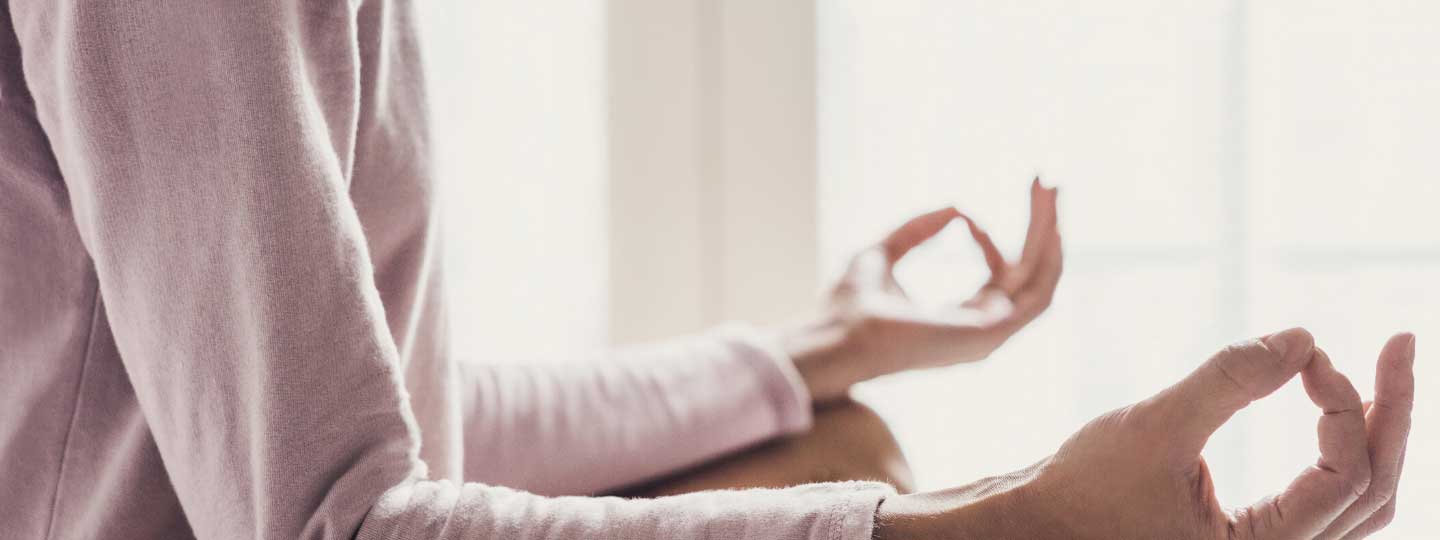Meditation and mindfulness and how it might help you
23 February 2022
It’s important to try to be kind to your mind and your body when you live with arthritis.
Studies have shown that meditation and breathwork can be used to help provide coping strategies, reduce anxiety and enable you to learn more about how your mind works.
When you’re in pain, getting ‘comfortable’ to relax your mind may feel challenging. Here’s some advice and tips to give you a positive toolkit of meditation and mindfulness techniques.
We’re all different and finding what feels right and works for you is important. It might be that you choose yoga as your preferred meditative exercise or you find that 5 minutes practicing breathing exercises every morning helps.
Learn how breathing exercises can help you relax and ease insomnia and pain.
What is mindfulness?
Mindfulness is a meditative technique that involves reconnecting to our bodies and focusing on our thoughts in a non-judgemental way. It can be something you do for a few minutes (or longer), in a place that’s comfortable for you.
Some people find the practice helpful as it can relax the mind and with regular practice it can change thinking patterns to encourage physical and emotional wellbeing.
The National Institute for Clinical Excellence (NICE) recommend mindfulness as a preventative practice for people with recurring experience of anxiety and depression.
“We often don’t realise that our minds are constantly chattering, which can be stressful. What will I make for tea? How am I going to manage in 10 years’ time? You have to bring yourself back to the here and now – push negative thoughts away. Stress intensifies pain, but being mindful means, I am less stressed, so the pain is more manageable.”
Read more about complementary therapies and which ones might be right for you.
What are the benefits of meditation and mindfulness?
Studies have documented a variety of benefits from practising regular meditation and mindfulness. By taking the time to look after ourselves, we can take a pause, recognise how we feel, take time to recharge, understand how our minds work and experiment with activities to help sooth our wellbeing.
These can vary from yoga, tai chi, relaxing breathing or using a guided meditation app such as Headspace or Calm.
Read more from the NHS about the benefits of mindfulness
“I use a combination of methods to help manage my pain. I use mindfulness, stretching exercises, walking, arthritis gloves, a TENS machine, analgesic gels as well as painkillers. I try to go walking and cycling as much as possible and having a mainly positive attitude has helped me get through.”
Tuning into your thoughts and being aware how you feel can be beneficial to you and to others living with arthritis.
“Being able to link up with other young people has completely changed the way I feel about my condition. I used to feel very alone. I hope that this (Arthritis Tracker) app helps other young people to become part of a community who are here to support each other.”
Our Arthritis Tracker app for young people is helping those affected to track their symptoms such as pain, fatigue and emotional wellbeing. Read more about the app.
Find what works for you
There are many different techniques you can try if you’re new to mindfulness and meditation.
- Learn more about the 5 steps for mental wellbeing.
- Take the time to appreciate nature and notice how this can improve your mood.
For Sharon, noticing the small joys in everyday and keeping a gratitude diary has helped her. Read Sharon's story.
“The biggest change for me is I feel more positive as I'm making these changes. The size is irrelevant, it’s the changes that matter. These little changes have already added up to a bigger change in how I'm feeling about my life as a whole. I'll continue to commit to these changes, even if I miss some weeks. It just feels like a proactive way of managing my life with arthritis now and in the future.”
Full body stretching: Evening routine
How to get started
Here are our tips to help you get started with meditation, breathwork and mindfulness:
- Find a place to practice which is comfortable for you. This can be inside your home, in the garden, out in nature or during a break in your working day. For your meditation, you can choose whether to be seated, standing or walking.
- Choose a regular time that works for you, whether that’s first thing in the morning or before you go to sleep.
- Set aside an amount of time that feels right.
- Experiment and find what you enjoy. If 10-minute sessions listening to relaxing music gives you the boost you need or if you prefer a weekly yoga session, that’s all ok.
- If you meditate and your mind gets distracted, that’s ok too. If this happens, simply let the thoughts come and go.
We’re here whenever you need us.
- If you would like to talk to someone, you can call our free helpline on 0800 5200 520 (Monday to Friday, 9am to 6pm)
- Chat to AVA, our Virtual Assistant, using the icon in the bottom right corner of this page
- Join our online community
- Stay in touch and follow us on Twitter, Facebook and Instagram.
You might also be interested in...
-
Sleep
Disturbed sleep can affect your health and make the symptoms of arthritis worse. Find out how arthritis can affect sleep and how to improve your sleep pattern.
-
Ways to manage your pain while waiting for surgery
We know that many of you are living with pain whilst waiting for surgery. We asked our community for their advice on managing pain and here’s their tips.